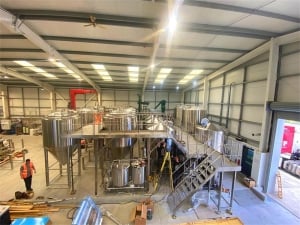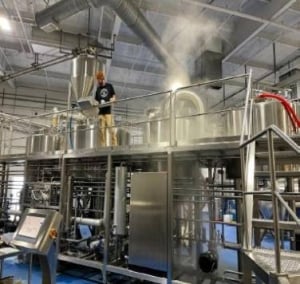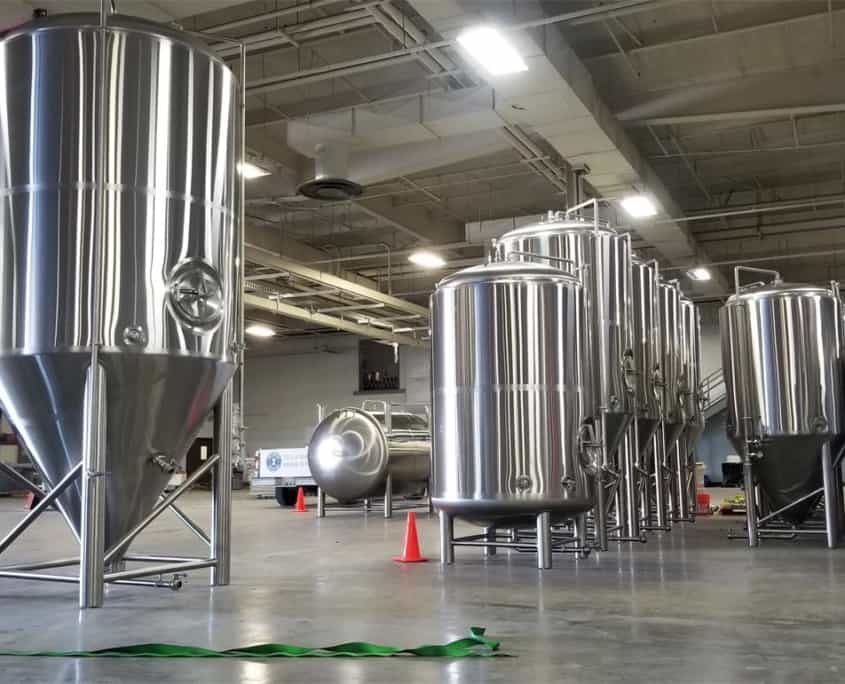 Every brewer is getting excited when he receives his brand new brewery tanks (specially if it’s a new site), and he can’t wait to try to produce amazing beers. But you can not just start brewing immediately, there are still a lot of work to do before you brew your first beers.
Every brewer is getting excited when he receives his brand new brewery tanks (specially if it’s a new site), and he can’t wait to try to produce amazing beers. But you can not just start brewing immediately, there are still a lot of work to do before you brew your first beers.
Tanks cleaning is one of the most important things to do before you start brewing any beer, as sometimes you might find uninvited surprises in your tank- Such as dust, residual water and even rust on the surface or tank ports. You have to know how to clean them properly to ensure the tanks are sparkling clean, otherwise you’re risking the first batch of your beer. Here’s some tips on how to clean the tanks. This is applied to any brewery tank smaller than 100bbl. Bigger tanks will need to be handled by a professional clean team.
We got the cleaning tips from a professional chemist and combined them with our years of experience. In general, you need to get the cleaning tools ready, learn the instructions and procedures, then get the cleaning work done. Easy said than done (like always :))
A. The Cleaning Object
Stainless steel tank, stainless steel pipe (hard pipe) and hose (soft pipe)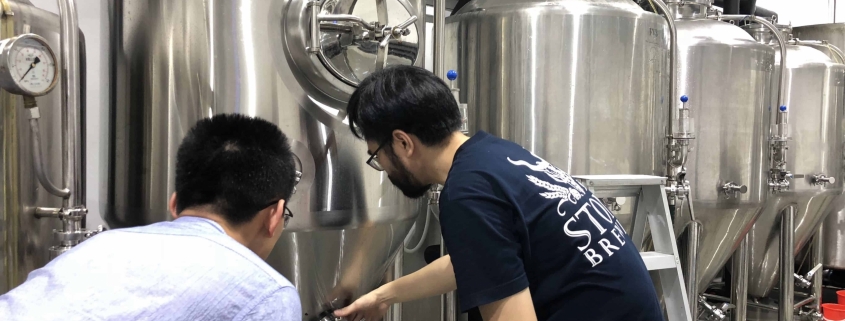
B. The Cleaning Tools/Material Preparation
Get the tools ready first so you don’t waste your precious time.
- Safety Gear
- Pump with cycle pipes (CIP skid if available)
- Clean Water
- Heat Source to Heat the Water
- Citric Acid
- Dilute Sodium Hydroxide
- Hydrogen Peroxide Solution
- Phoshated, Silicated, and Oxygenated Non-Caustic Alkaline Cleaner
- 75% Ethyl Alcohol
C. General requirements
- pipe flow rated≥5m/s
- Check if there’s rubbish in the tank or the pipes, and clean it (duh).
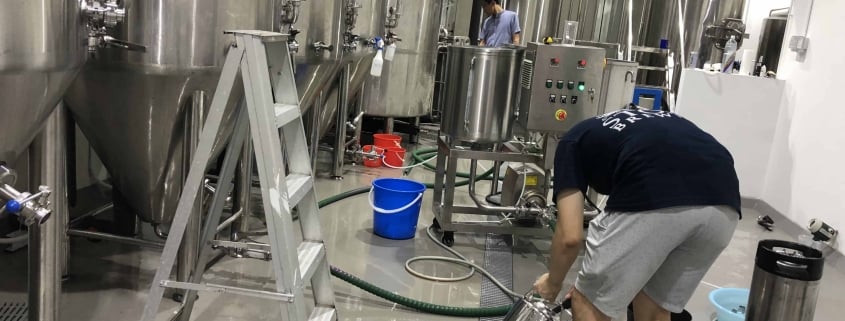
- Make sure the safety device does work, such as PVRV valves on the fermenters. Also check the gaskets, end caps and valves to make sure there is no leakage and all the electric parts are working well.
- Protective measure – Protect your skin and eyes from touching any acids or caustic! You should wear clothes that can cover all your skin, including rubber gloves and shoes. If you don’t have it make sure to purchase it. If you do touch those chemicals by accident, clean it immediately with running water and use soda water and vinegar to neutralize it or go to hospital if the situation is worsen.
D. Cleaning Process
1) Stainless Steel Tanks and pipe line cleaning
First thing is to remove any machinery oil, road grim and dust, and the second thing is to do a conversion coating in your site if needed. Eventually we’ll need to clean the hose, the valves and the fittings. As there are many different recipes on how to clean the tanks, you can decide which procedures to follow according to your current state.
| Part1) Machinery Oil, Road Grim And Dust Removal | |||||
| Step | Process | Cleaning Chemical | Time | Temperature | Remark |
| 1 | Water cleaning | Hot water | 10-15min | 140-150 F | Wash residue and dirt |
| 2 | Caustic cleaning | 2-2.5% dilute sodium hydroxide | 30min | 175-195 F cycle cleaning | Remove machine oil, road grim |
| 3 | Water cleaning | Hot water | 15-30min | 140-176 F | Clean the caustic in the tanks
(PH test paper detects water neutrality) |
| 4 | Acid washing | 12-13% citric acid | 30min | 120-130 F | Remove surface dust |
| 5 | Water cleaning | Hot water | 15-30min | 140-176 F | Clean the acid in the tanks
(PH test paper detects water neutrality) |
| Part 2) Conversion Coating Passivation If Needed | |||||
| Step | Process | Cleaning Chemical | Time | Temperature | Remark |
| 6 | Acid washing | 12-13% nitric/phosphoric acid | 15-30min | 120-130°F | Passivation |
| 7 | Drain | / | / | / | Not Rinse |
| 8 | Caustic cleaning | 12-13% Phosphated, silicated and oxygenated non-caustic alkaline | 15-30min | 120-140°F | Conversion coating |
| 9 | Water cleaning | Hot water | 15-30min | 140-176 F | Rinse |
| Part 3) Sterilization | |||||
| Step | Process | Cleaning Chemical | Time | Temperature | Remark |
| 10 | Sterilization | 2-2.5% Hydrogen peroxide solution | 20min | 68 F
Normal Temperature |
Sterilizing for brewing and collect use as sterile water |
| 11 | Sterile water | Use the collected sterile water or made new one-35% Hydrogen peroxide solution, 1:3000 adding water mixing for 100min | 10min | Normal Temperature | Rinse and Clean |
| 12 | Sealing | / | Sealing pipe and valves tightly and ready for brewing | ||
 2) Hose cleaning
2) Hose cleaning
- Cleaning with 1% dilute sodium hydroxide at 175-195 F for 15mins, then rinse with water
- A container with 1% hydrogen peroxide solution at normal temperature for 120 min
- Do not clean with copper fittings or chloride ion water, as the hose condition will be deteriorating
3) Valves and fittings cleaning
- Use a sprinkling can filled with 75% Ethyl Alcohol to clean the valves, gaskets and fittings when you assembly and replace.
4) Tank outside surface
- If the tanks’ outside surface is dirty, you can clean the stains manually by using some detergent that’s all. Try not to damage the surface with nasty scratches.
Above should follow in a reasonable time and procedures. If the cleaning process takes too much time it may cause a huge damage to the tanks.
Please take extra care when using citric acid and nitric acid in the cleaning process.
A better way to clean Brand New Brewery Tanks
Congratulations on your new brewery tanks! It’s exciting to bring a dream of brewing your craft beer to life, but cleaning those sparkling new tanks is an essential first step. A thorough cleaning ensures optimal performance, prevents contamination, and keeps your beer tasting its best. This guide will walk you through everything you need to know about cleaning your brand-new brewery tanks.
Overview: Why Cleaning Brewery Tanks Matters
Properly cleaning your brewery tanks isn’t just about hygiene—it’s about preserving the integrity of your beer and ensuring the longevity of your equipment. Brewery tanks, no matter how pristine they look upon arrival, can harbor oils, debris, and contaminants from the manufacturing and shipping process.
Key Points to Remember:
- Preservation of Flavor: Residual oils or chemicals can alter the taste of your beer.
- Prevention of Contamination: Harmful bacteria or yeast strains can thrive in unclean tanks.
- Equipment Longevity: Routine cleaning prevents corrosion and buildup, keeping your tanks in top condition.
Guide to Brewery Tank Cleaning Equipment
Cleaning brewery tanks requires specific tools and chemicals. Here’s a detailed guide to the equipment you’ll need and its purpose.
| Equipment | Purpose | Examples |
|---|---|---|
| Spray Balls | Distribute cleaning solutions inside the tank for uniform cleaning. | Fixed or rotating spray balls. |
| Pumps | Circulate cleaning chemicals at the correct pressure for effective cleaning. | CIP (Clean-in-Place) pumps. |
| Caustic Cleaners | Break down organic residues such as fats and proteins. | Sodium hydroxide solutions. |
| Acid Cleaners | Remove mineral deposits like beer stone. | Phosphoric or nitric acid. |
| Brushes and Pads | Hand tools for scrubbing stubborn spots or external surfaces. | Soft-bristle tank brushes. |
| pH Strips/ Meters | Measure the pH levels of your cleaning solutions for safety and efficacy. | Digital or paper strips. |
| Personal Protective Equipment (PPE) | Ensure safety during chemical handling. | Gloves, goggles, aprons. |
How to Clean Your Brewery Tanks
Cleaning a brewery tank involves several steps. Each step is critical to achieving a sanitary brewing environment. Here’s a step-by-step guide:
1. Pre-Clean Inspection
Before diving into cleaning, inspect the tank for any visible debris, dents, or scratches. This step ensures no physical contaminants remain and identifies any potential issues early.
2. Rinse with Warm Water
Using warm water, rinse the tank thoroughly to remove loose particles and soften residues. The goal here is to eliminate as much surface dirt as possible before applying chemicals.
3. Apply a Caustic Solution
Use a caustic cleaner to break down organic material like oils and proteins. This step often involves circulating the solution through the tank with a Clean-In-Place (CIP) system.
- Concentration: Follow the manufacturer’s recommendations.
- Temperature: Ideal temperature ranges between 50°C to 70°C (122°F to 158°F).
- Duration: Allow the solution to circulate for 20–30 minutes.
4. Rinse and Neutralize
After draining the caustic solution, rinse the tank thoroughly with clean water. Check the pH levels to ensure no residual alkalinity remains.
5. Acid Cleaning
Acid cleaning removes mineral deposits like beer stone. Circulate an acid solution (phosphoric or nitric acid works well) to dissolve these deposits and leave your tank shining.
6. Final Rinse and Sanitization
Perform a final rinse with clean water, then sanitize the tank using a brewery-approved sanitizer. This ensures the tank is ready for brewing.
Key Considerations When Choosing Brewery Tanks
Selecting the right brewery tanks can save time and effort in cleaning. Here’s a comparative guide to help you make an informed decision.
| Feature | Option A | Option B | Recommendation |
|---|---|---|---|
| Material | Stainless Steel | Plastic or Other Metals | Stainless steel is easier to clean. |
| Design | Welded Seams | Bolted Seams | Welded seams reduce contamination risk. |
| Capacity | 1–10 BBL | Over 10 BBL | Smaller tanks are easier to clean. |
| Cleaning Compatibility | CIP Ready | Manual Cleaning Only | CIP systems are highly recommended. |
Brewing Process and Tank Cleaning Integration
Cleaning isn’t a one-and-done task. It’s an ongoing part of the brewing process. Here’s how it integrates seamlessly:
- Before Brewing: Always clean your tanks to remove potential contaminants.
- During Brewing: Perform quick rinses between batches, especially when brewing different styles of beer.
- After Brewing: Deep clean to remove residues and ensure the tank is ready for the next batch.
Supplier and Pricing Comparison for Brewery Tanks
Finding the right tank supplier impacts your cleaning routine and overall brewing efficiency. Here’s a snapshot of leading suppliers.
| Supplier | Price Range | Customization Options | Reputation |
|---|---|---|---|
| ABC Brewing Co. | $5,000–$15,000 | Yes | High Customer Ratings |
| CraftMaster Systems | $8,000–$20,000 | Yes | Renowned for Quality |
| BrewTech Industries | $10,000–$25,000 | Yes | Reliable Service |
Installation, Operation, and Maintenance
Cleaning begins with proper installation and continues through routine maintenance. Ensure your tank is installed level and follows the manufacturer’s guidelines for operation.
| Aspect | Tips and Best Practices |
|---|---|
| Installation | Use professionals to ensure proper alignment and sealing. |
| Operation | Train staff on CIP protocols to avoid mishaps. |
| Maintenance | Schedule regular inspections for wear and tear. Replace gaskets and seals as needed. |
FAQs on Cleaning Brand New Brewery Tanks
| Question | Answer |
|---|---|
| Why clean a new tank? | Removes oils, debris, and contaminants from manufacturing and shipping. |
| How often should I clean my tanks? | Before brewing, between batches, and after every brewing cycle. |
| What is the best cleaner for brewery tanks? | A combination of caustic cleaners for organics and acids for minerals. |
| Can I clean manually without CIP equipment? | Yes, but it is labor-intensive and less effective. |
Conclusion
Cleaning your brand-new brewery tanks is an essential step in your brewing journey. With the right equipment, techniques, and commitment to cleanliness, you’ll ensure not just great-tasting beer but also a long life for your brewing setup. Got any more questions? Let’s keep the conversation brewing!

